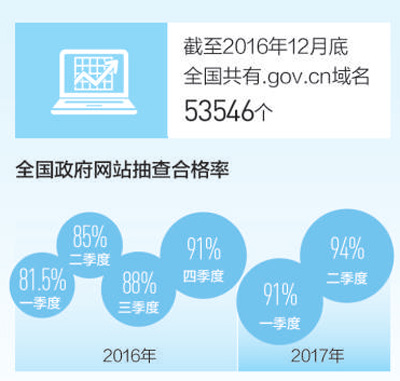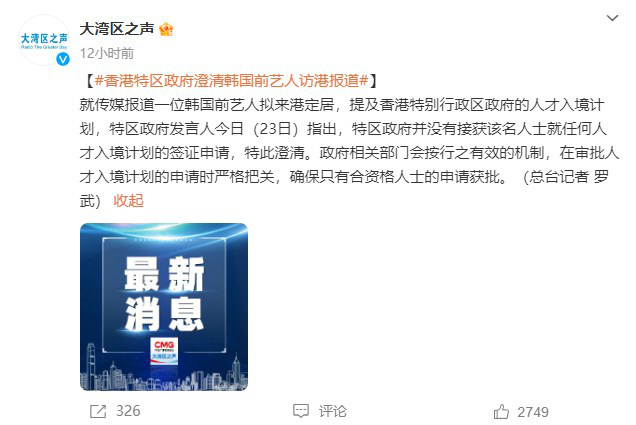
Data source: China government website, Statistical Report on Internet Development in China.
Government information can be known with one click. Since the 18th National Congress, China’s e-government construction has entered the "fast lane" and achieved remarkable results. With the rapid development of e-government, the information barriers of government departments at all levels have been broken, the service efficiency has been improved, and the problems of difficulty, slowness and complexity have been solved. At present, China is promoting the modernization of national governance system and governance capacity by informatization. As an important force to promote the modernization of national governance, informatization is triggering a new round of government governance model reform.
— — Editor
The State Council departments and directly affiliated institutions that open government websites.
71
In recent years, the release of government information has become more and more timely, which not only facilitates people’s access to information, but also improves the transparency of government work and the trust between the government and the public. At the same time, more and more government departments focus on policy interpretation, and interpret policy documents from the perspective of public demand in an easy-to-understand language form, so that the public can understand and be willing to read and like to read.
— — Zhang Shaotong, Deputy Director of Tsinghua University E-government Laboratory
According to the statistics of the National Governance Institute of Tsinghua University, as of the end of June 2017, 71 the State Council departments and directly affiliated institutions had opened government websites, of which about 92.9% had established an information publishing system and about 80.3% had published government information online; As of mid-July, 2017, 19 departments and directly affiliated institutions in the State Council have opened government affairs apps.
In recent years, with the popularity of government websites, Weibo, WeChat, mobile APP and other government platforms, government information has been online in succession, and information release has gradually entered the right track.
The "hard lever" of information release is more clear. In November last year, the State Council issued the "Detailed Rules for the Implementation of the Opinions on Comprehensively Promoting the Openness of Government Affairs", which clearly defined the five-hour time limit for major emergencies for the first time; In May this year, the "Guidelines for the Development of Government Websites" was published, providing clear "operational guidelines" for timely information release of government websites at all levels; In June this year, the Regulations on the Openness of Government Information in People’s Republic of China (PRC) (Revised Draft for Comment) was promulgated, which clearly wrote the principle of "openness as the norm and non-disclosure as the exception" into the regulations, stipulating that "government information should be made public unless otherwise stipulated by laws and administrative regulations"; In the first half of the year, the State Council announced the "Pilot Work Plan for Standardization of Grass-roots Government Affairs Openness", and tried to explore an operational government information disclosure standard &hellip in 100 counties (autonomous regions and municipalities) in 15 provinces, autonomous regions and municipalities across the country; …
Information release is more timely. In June this year, a mountain collapse occurred in Maoxian County, Sichuan Province. The website of the Sichuan provincial government immediately collected information from a number of related units through the provincial government information disclosure directory system, and released the disaster situation and related information at the first time, releasing 55 pieces of information on the same day. Good performance in emergencies benefits from the gradual maturity of daily publishing work. For example, in recent years, many rounds of "big and small exams" on government websites across the country have imposed time limits on the timeliness of forwarding information on government websites.
Information release is more in place. Not long ago, the General Office of the Beijing Municipal Government, together with 13 municipal government departments, took the lead in formulating a "map of making government affairs public, benefiting the people and facilitating the people" around the general needs of the public and key livelihood issues, covering the government information that the masses are most concerned about. Citizens can get a glimpse of government affairs information through "a map". In addition to innovative forms of information release, more and more government websites and government service platforms regard easy-to-understand interpretation as a "standard" when releasing policy information, so as to avoid policy release becoming an online display.
The "nerve endings" of information release are more alive. How to "break" the openness of government affairs in a village? The people in Changtang Town, Shangyu, Shaoxing City, Zhejiang Province have new choices besides consulting the information of their village on the local government website. The town integrates network resources to open the "Zhuyun Changtang" WeChat public account, which is published once a week, covering the work dynamics of the party Committee and government, convenience service information, emergency warning and so on. Since the beginning of this year, the company has handled more than 300 fan messages, among which many messages about sanitation rectification have been adopted and urged relevant departments to handle them. Throughout the country, such grass-roots "information transmitting stations" are constantly emerging. With the help of the information highway, the government is around the people.
The provincial integrated service platform has grown in the past three years.
3.25 times
From "people running back and forth" to "running at most once" and then to "not running at all", there is no end to the road of optimizing and upgrading, facilitating the people and benefiting enterprises. The key of "Internet+government service" in the next stage is to embody the service quality in details, expecting the government service platform to continuously improve and perfect the service process and actively accept user feedback.
— — Huang Huang, Associate Professor, School of Government Administration, Peking University
How long does it take to register a business? It only takes 38 minutes in Qionglai Municipal Affairs Service Center, Sichuan.
Last year, Lao Yang, a farmer who lives 50 kilometers away from Qionglai city, wanted to register a family farm. In the past, he had to go to the market supervision bureau to approve the pre-name of the enterprise, and then go through the registration formalities with the information after the approval. He said, "Even if everything goes well, it will take three trips."
Now, get it done online first, and make a trip all the way. According to the prompt of "Qionglai Service" on the WeChat account of the Municipal Affairs Service Center, Lao Yang downloaded the service guide and forms, submitted the approval materials, and received the notice that the enterprise name had been approved in less than one day. After that, he came to the window of the market supervision bureau on the agreed day, and the data review was passed at one time. After 38 minutes, Lao Yang got the business license. This all stems from Qionglai’s implementation of the reform of "five certificates in one" and "first license before license" in enterprise registration, and making full use of the Internet to realize online pre-trial and offline processing.
In recent years, the "internet plus" gene has been more deeply implanted in government affairs, and online and offline services have been more closely integrated. In September last year, the State Council issued the "Guiding Opinions on Accelerating the Work of" Internet+Government Services ",demanding that by the end of 2020, the Internet and government services should be deeply integrated, and the" Internet+Government Services "system covering the whole country with overall linkage, departmental coordination, provincial-level overall planning and one network management should be built; In January this year, the State Council issued the Guide for the Construction of the Technical System of "Internet+Government Services", and put forward the information solution path and operation method around the technical support of "Internet+Government Services".
At present, building an online government service platform is listed as an important goal for all regions and departments to build an integrated government service system. According to the statistics of Tsinghua University National Governance Research Institute, as of mid-July this year, 17 provincial-level (provincial, city and county) integrated service platforms have been launched nationwide, an increase of 3.25 times compared with the four provincial-level integrated platforms in 2014, and more than 40,000 business services have been stationed in the platforms.
In addition, more and more local governments are innovating government services, and strive to bring more tangible and comfortable experiences to the people. Not long ago, the comprehensive service platform for export tax rebate in Shenyang was launched. The average export tax rebate for 3,450 export enterprises in the city was reduced from 15 working days to 8 working days, and the review progress was accelerated by 47%. In June this year, Jiangsu government affairs service network was put into trial operation for five months, and the service contents were constantly superimposed. In addition, it cooperated with EMS to promote the business of "seeing once" and "not meeting", which greatly increased the efficiency. In recent years, Hainan has built a mode of combining entity and online government affairs hall to realize "one-net approval" in the whole process. At present, the utilization rate of the whole province is 100%, and 2,370 villagers’ convenience service stations also use "one-net approval", accounting for 78.8% of the number of completed & hellip; …
By the end of last year, there were gov.cn domain names in China.
53,546
Promoting the openness and sharing of government data will realize public-centered service delivery. The continuous improvement of business collaboration and data sharing of back-end government information system will become one of the focuses of e-government development. By strengthening the formulation of metadata standards, data cataloging management and cross-system interface integration, the cooperation ability between systems will be continuously improved and the "obstruction" of data circulation will be reduced.
— — Wang Fang, Professor of Nankai University Business School
"Once blacklisted, it is restricted everywhere." At the beginning of the year, a person in charge of an enterprise going to Hong Kong for business talks was told at the local entry-exit frontier inspection station that it was restricted from leaving the country, because his enterprise was included in the "blacklist" of tax violations for evading the recovery of tax arrears.
Login to "Credit China" website, users can not only search the data resources such as the list of people who have broken their promises and the parties involved in major tax violations with one click, but also quickly browse the "blacklist of punished persons" including restricting their participation in project bidding. Since its launch, "Credit China" has published more than 100 million pieces of information, and its website has more than 5 million daily visits. As the information support behind it, the national credit information sharing platform has connected 37 departments and all provinces, autonomous regions and municipalities, and collected nearly 2.2 billion pieces of various credit information.
Public sharing can release the data’s due value. By the end of December 2016, there were 53,546 "gov.cn" domain names in China. As of the first half of 2017, 19 provinces in China have launched data open platforms, and government data are as open as possible to the whole society, which not only improves the efficiency of government operations, but also makes people enjoy information convenience. All 31 provinces in China have published the list of rights of provincial government departments, and the provincial online government service platform has published a total of 44797 work guides.
Which key construction projects in the province are under construction? Are there any designated hospitals and pharmacies for medical insurance nearby? In September 2015, the special website of "Data Opening" of Zhejiang Government Service Network was officially launched, becoming the first unified and open platform for government data in China after the release of the Action Plan for Promoting Big Data Development. The first batch of open data resources include 350 data categories provided by 68 provincial units, and users can easily query and download them by logging on the corresponding pages. Data open platforms in other places have also benefited the public.
Data sharing is smoother and government services are more efficient.
At present, in Guizhou Province, more than 20,000 examiners at all levels and departments use "one system for examination and approval", with an average daily processing volume of over 30,000 and an online application rate of 100%. Guizhou province weaves a "web" with an efficient and smooth data sharing system — — Online service hall in Guizhou province.
Promote data openness, with clear timetable and clear road map. In 2015, the State Council issued the "Action Plan for Promoting the Development of Big Data", which clearly stated that government data should be gradually opened to the public in areas related to people’s livelihood security services such as credit, transportation, medical care, health and employment by the end of 2020; In July 2016, the Outline of National Informatization Development Strategy further put forward the goal of "building a public information resource open directory project and building a unified, standardized, interconnected, safe and controllable national data open system"; A few days ago, the "Guide to the Compilation of Government Information Resources Catalogue (Trial)" made a detailed plan for the practical standard of "how to open up".





